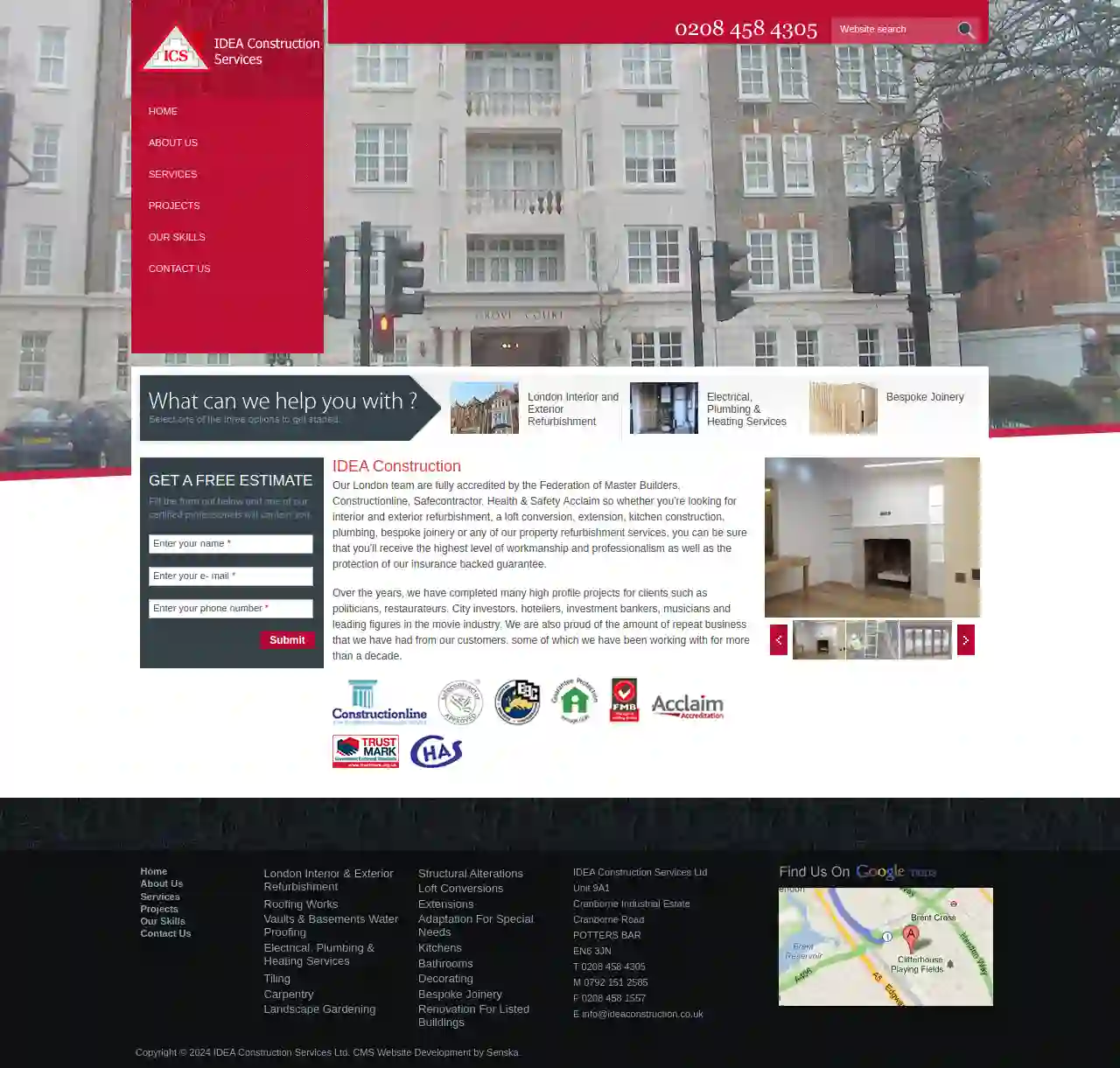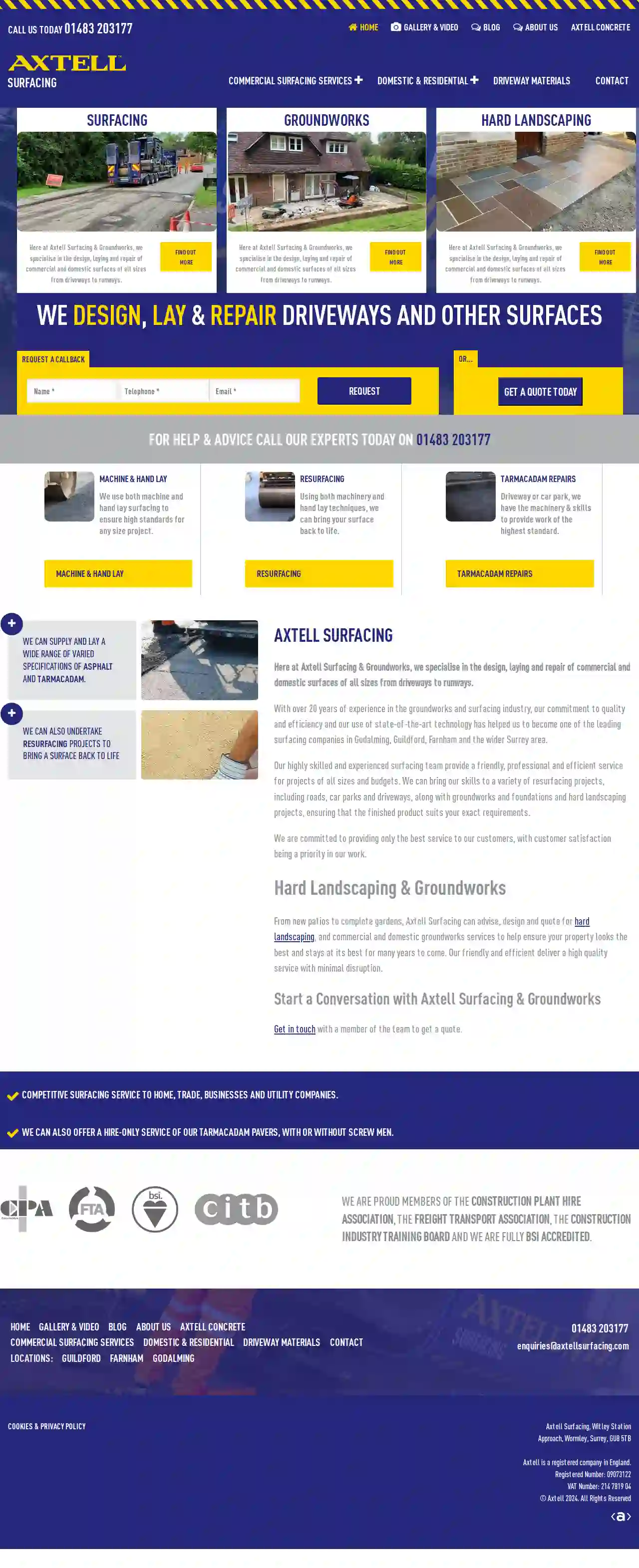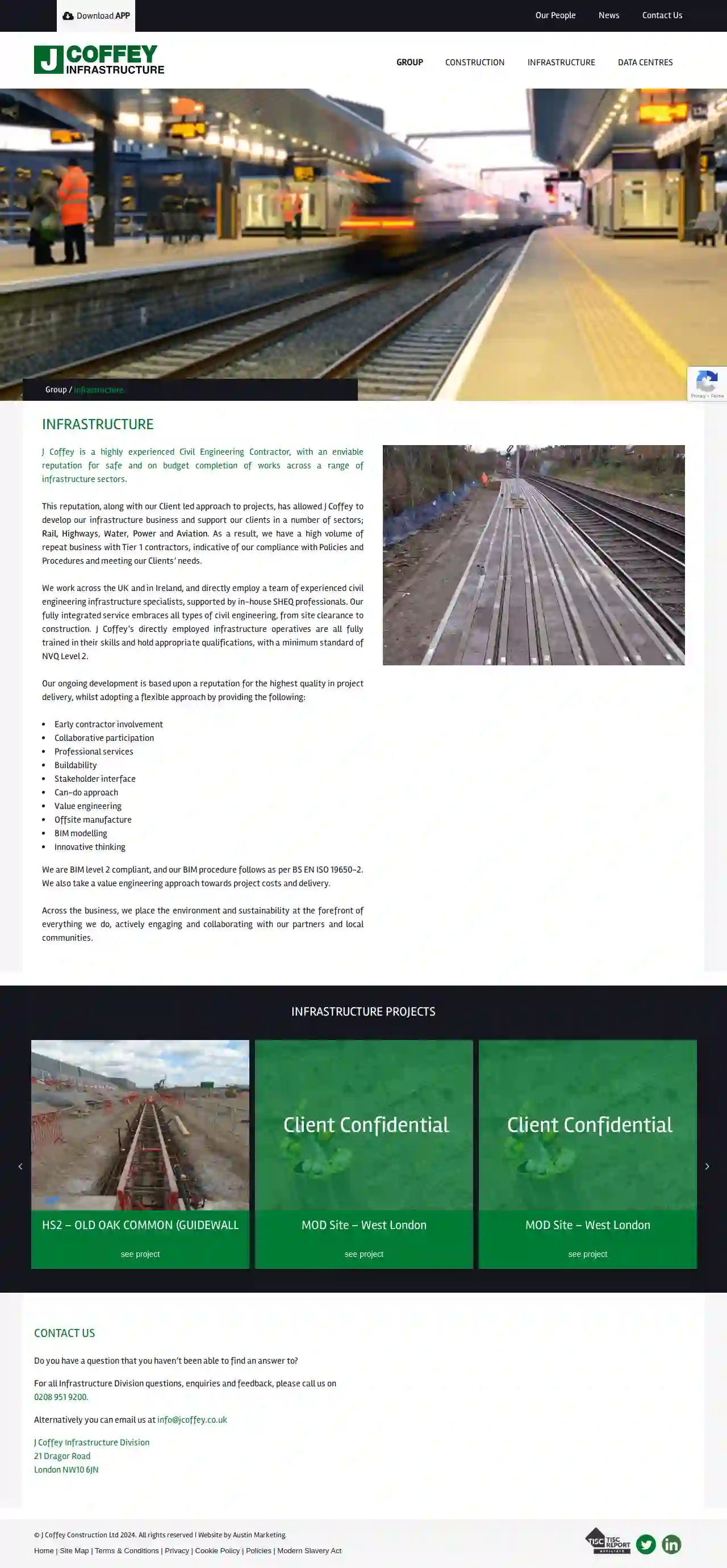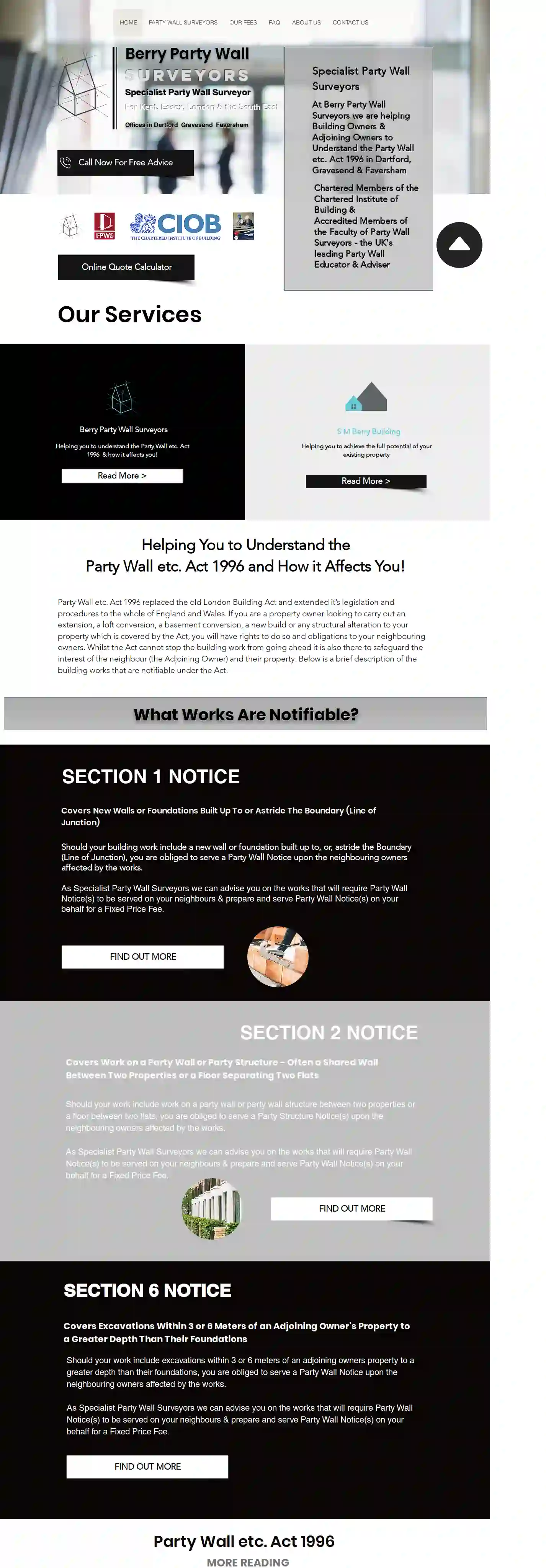Excavation Contractors Balham
Find Excavation Contractors Near Me in Balham
Get 3 FREE Digging Contractors quotes for your project today! Compare profiles, reviews, accreditations, portfolio, etc... and choose the best service.

Idea Construction Services Ltd
Unit 9A1 Cranborne Industrial Estate, Cranborne Road, Unit 9A1 Cranborne Industrial Estate Cranborne Road, POTTERS BAR, EN6 3JN, GBIDEA Construction: Your Trusted London Refurbishment Partner IDEA Construction is a leading London-based construction company specializing in a wide range of refurbishment and building services. We are fully accredited by the Federation of Master Builders, Constructionline, Safecontractor, and Health & Safety Acclaim, ensuring the highest standards of workmanship and professionalism. Our commitment to quality is reflected in our insurance-backed guarantee, providing you with peace of mind throughout your project. We have a proven track record of delivering exceptional results for a diverse clientele, including politicians, restaurateurs, City investors, hoteliers, investment bankers, musicians, and leading figures in the movie industry. Our dedication to customer satisfaction is evident in the high volume of repeat business we receive, with some clients trusting us for over a decade. IDEA Construction began as a small business in 2003 and has grown steadily, becoming a limited company in 2006. In 2009, we expanded our services by opening a bespoke joinery workshop, allowing us to reduce reliance on subcontractors, maintain high standards, and expedite project completion. As we celebrate our tenth anniversary, we remain committed to providing exceptional construction services in London. Our team of skilled professionals is dedicated to delivering projects on time and within budget, exceeding your expectations at every stage.
- Services
- Why Us?
- Accreditations
- Gallery
Get Quote
ALSTRUCT Ltd
52 reviewsLondon, GBAbout Alstruct Alstruct is your one-stop solution for all your construction needs. With a commitment to excellence and a passion for precision, we offer a diverse range of specialized services to transform your vision into reality. Our expertise encompasses a wide spectrum of construction services: Ground Works, Drainage, Landscaping, and Paving: We believe in setting a solid foundation for success. Whether it’s designing effective drainage solutions, crafting captivating landscapes, or creating impeccably paved surfaces, we’re here to lay the groundwork for your dreams. Renovations, Fit-Outs, Painting, and Decorations: Your space should reflect your unique style and vision. Our team specializes in breathing new life into existing spaces, customizing interiors to your exact specifications, and adding the perfect finishing touches with expert painting and decorations. Reinforced Concrete Frames, Basements & Retaining Walls, Staircases: Structural integrity is at the core of our construction philosophy. Our expertise in reinforced concrete frames, basements, retaining walls, and intricate staircases ensures the durability and stability of your project. Brickwork & Stonework, Tiling: Our craftsmen possess an innate talent for the artistry of brickwork, stonework, and precision tiling. They create timeless and breathtaking finishes that enhance the beauty and elegance of your projects. Our Vision We place customer satisfaction and the quality at the heart of everything we do. Our clients’ dreams and aspirations for the best quality are our guiding stars. We listen, we understand, and we bring their visions to life in a way that exceeds their wildest expectations.
- Services
- Why Us?
- Gallery
Get Quote
Axtell Surfacing & Groundworks
53 reviewsAxtell Surfacing, Witley Station Approach, Wormley, Surrey, GU8 5TB, GBAxtell Surfacing & Groundworks Here at Axtell Surfacing & Groundworks, we specialise in the design, laying and repair of commercial and domestic surfaces of all sizes from driveways to runways. With over 20 years of experience in the groundworks and surfacing industry, our commitment to quality and efficiency and our use of state-of-the-art technology has helped us to become one of the leading surfacing companies in Godalming, Guildford, Farnham and the wider Surrey area. Our highly skilled and experienced surfacing team provide a friendly, professional and efficient service for projects of all sizes and budgets. We can bring our skills to a variety of resurfacing projects, including roads, car parks and driveways, along with groundworks and foundations and hard landscaping projects, ensuring that the finished product suits your exact requirements. We are committed to providing only the best service to our customers, with customer satisfaction being a priority in our work. Hard Landscaping & Groundworks From new patios to complete gardens, Axtell Surfacing can advise, design and quote for hard landscaping, and commercial and domestic groundworks services to help ensure your property looks the best and stays at its best for many years to come. Our friendly and efficient deliver a high quality service with minimal disruption.
- Services
- Why Us?
- Accreditations
- Gallery
Get Quote
London Borough of Waltham Forest
2.48 reviewsLondon, GBWaltham Forest Council: Serving Our Community Waltham Forest Council is dedicated to providing essential services and improving the lives of residents in the borough. We work tirelessly to create a thriving community where everyone can flourish. Our commitment to residents is reflected in our wide range of services, from supporting families and children to promoting health and wellbeing, and ensuring a clean and safe environment. We are committed to transparency and accountability, and we strive to be responsive to the needs of our community. We encourage residents to get involved in shaping the future of Waltham Forest by participating in consultations and events. Explore our website to discover the services we offer, find information about local events, and learn how you can get involved in making Waltham Forest a better place for everyone.
- Services
- Why Us?
- Gallery
Get Quote
J Coffey Infrastructure
51 reviews21 Dragor Road, London, NW10 6JN, GBJ Coffey: Your Trusted Infrastructure Partner J Coffey is a highly experienced Civil Engineering Contractor, renowned for delivering safe and on-budget infrastructure projects across various sectors. Our client-centric approach has allowed us to build a strong infrastructure business, supporting clients in Rail, Highways, Water, Power, and Aviation. This commitment to client satisfaction has resulted in a high volume of repeat business with Tier 1 contractors, demonstrating our adherence to policies, procedures, and client needs. We operate across the UK and Ireland, employing a team of experienced civil engineering infrastructure specialists backed by in-house SHEQ professionals. Our fully integrated service encompasses all aspects of civil engineering, from site clearance to construction. Our directly employed infrastructure operatives are fully trained, hold appropriate qualifications, and meet a minimum standard of NVQ Level 2. Our continuous development is driven by a commitment to delivering the highest quality projects while maintaining a flexible approach. We offer: Early contractor involvement Collaborative participation Professional services Buildability expertise Stakeholder interface management A "can-do" attitude Value engineering solutions Offsite manufacturing capabilities BIM modeling expertise Innovative thinking We are BIM level 2 compliant, adhering to BS EN ISO 19650-2 standards. We also prioritize value engineering to optimize project costs and delivery. Throughout our operations, we prioritize environmental sustainability and actively engage with our partners and local communities.
- Services
- Why Us?
- Gallery
Get Quote
J & Z Construction Ltd
4.111 reviewsUnit 14, 715 North Circular Road London NW2 7AQ, London, NW2 7AQ, GBJ&Z Construction: Your Trusted Partner for Building Excellence in London For over a decade, J&Z Limited has been a leading name in construction, providing exceptional service to clients across London and its surrounding areas. Our team of highly skilled builders and architects is dedicated to delivering the highest quality craftsmanship and unwavering commitment to every project. We offer a comprehensive range of building services, catering to your diverse needs. Whether you're dreaming of a luxurious renovation, a spacious house extension, or a brand-new build, we have the expertise and experience to bring your vision to life. Our services encompass: Luxury Renovations House Extensions New Builds Complete Bathroom Refits Kitchen Installations Central Heating Systems Electrical Rewiring At J&Z Construction, we prioritize quality and customer satisfaction. All our work is fully insured and guaranteed, ensuring peace of mind and exceptional results.
- Services
- Why Us?
- Gallery
Get Quote
Berry Party Wall Surveyors
527 reviews53 Birchwood Road, Wilmington, Dartford, Kent., DA2 7HF, GBBerry Party Wall Surveyors Specialist Party Wall Surveyor For Kent, Essex, London & the South East Offices in Dartford Gravesend Faversham At Berry Party Wall Surveyors we are helping Building Owners & Adjoining Owners to Understand the Party Wall etc. Act 1996 in Dartford, Gravesend & Faversham Chartered Members of the Chartered Institute of Building & Accredited Members of the Faculty of Party Wall Surveyors - the UK's leading Party Wall Educator & Adviser Call Now For Free Advice Our Services
- Services
- Why Us?
- Our Team
- Testimonials
- Gallery
Get Quote
AD Bly Construction
3.634 reviewsNup End Business Centre, Old Knebworth, Nup End Business Centre Old Knebworth Hertfordshire, Knebworth, SG3 6QJ, GBAN INSPIRED APPROACH TO RESIDENTIAL, RETAIL, COMMERCIAL, INFRASTRUCTURE & EDUCATION CONSTRUCTION AD Bly Construction core skills Ground Works Civil Engineering Concrete Frames BUILDING PARTNERSHIPS FROM THE GROUND UP With retained staff at all levels and across every discipline we avoid the pitfalls of subcontracting. Our relationship with our staff is key to the success of our business and accordingly we have built a team with the skills, experience, and commitment to do an excellent job. This means we deliver consistently excellent results, on deadline and to budget, and consequently there is a growing demand for our work. learn More our clients
- Services
- Why Us?
- Our Team
- Gallery
Get Quote
Cosy Home Builders48
51 reviews27 Kingsdown Road, Leytonstone, London, GBCosy Home Builders48: Your Trusted Partner for Quality Home Renovations At Cosy Home Builders48, we are dedicated to transforming your dream home into a reality. We are a team of highly skilled and experienced professionals, committed to delivering exceptional craftsmanship and customer service. Whether you're looking for a complete home refurbishment, a stylish new kitchen, or a modern bathroom, we have the expertise to bring your vision to life. We understand that your home is your sanctuary, and we treat every project with the utmost care and attention to detail. Our commitment to quality is reflected in every aspect of our work, from the initial consultation to the final finishing touches. We are based in Leytonstone, East London, but our services extend across London, Kent, and Essex. Our gallery showcases a diverse range of projects, from house extensions and bathroom refurbishments to new conversions and garden outbuildings. We invite you to explore our portfolio and see the difference Cosy Home Builders48 can make. Contact us today for a free consultation and let us help you create the home of your dreams.
- Services
- Why Us?
- Our Team
- Gallery
Get Quote
Copues Construction
London, GBAbout Us Having been awarded an RIBA Regional Award, regarded as a mark of excellence, and Master Builder of the year (for contracts over £100,000), Copués Construction offer a highly skilled in-house workforce, exceptional craftsmanship, a breadth of knowledge and expertise and a dedicated team that can manage your project from drawing board to completion. Copués Construction regularly work in conjunction with English Heritage, achieving high standards in restoration refurbishment, in keeping with a buildings original period and character. They also undertake their own commercial development, both in the housing and commercial sectors. Having forged lasting relationships with their clients and architects, Copues Construction are proud that much of their business originates through recommendation. In addition to their private clients, their commercial portfolio includes, The Tower of London, Horse Guard Parade, the Foreign Office, the R.I.C.S (Royal Institute of Chartered Surveyors) Building, New Zealand House, Australia House, Harrow Boys School, The Hall School (Hampstead), Hadley Wood Golf, The Whites Club and Ickenham Manor. Copués Construction take their responsibility towards Health and Safety regulations seriously, and maintain full compliance during all projects. They also have full public and employers liability insurance Our Skills Design Copues Construction have the skills to achieve the design and detail for their projects, allowing the client to be ensured that they are focused on every aspect of how their home or building will be used as a practical space. Space Planning Kitchen Bathrooms Bespoke Cabinetry Construction Restoration / Conversion of Listed & Historic Buildings New Build Extensions Basement Excavations Heavy Structural Works Internal Moulding & Cornices External Stone Moulding & Cornices Glass & Steel Structures Barn Conversions Bespoke Joinery Management Copues Construction have considerable experience of high intensity projects, both new constructions and refurbishment and restoration. They understand the need to deliver projects on time and with no stress. Scheduling Planning Project Management Health and Safety Our Team Michael Copués Company Director Ruth Copués Director Nina Goodwin Designer Hayley Copués Accounts Manager
- Services
- Why Us?
- Our Team
- Testimonials
- Gallery
Get Quote
Over 13,059+ Excavation Businesses onboarded
Our excavation companies operate in Balham & surroundings!
ExcavationHQ has curated and vetted Top Excavation Contractors in Balham. Find a trustworthy contractor today.
Frequently Asked Questions About Excavation Contractors
- Project Type and Size: Ensure the contractor has experience handling projects similar to yours in scale and complexity.
- Reputation and Reviews: Check online reviews and testimonials, and request references from previous clients.
- Licensing and Insurance: Verify that the contractor is properly licensed and insured to protect you from liability.
- Equipment and Resources: Confirm that they have the necessary equipment and resources for your project's needs.
- Communication and Transparency: Choose a contractor who communicates clearly, provides detailed estimates, and keeps you informed throughout the project.
- Safety Record: Inquire about their safety protocols and track record to ensure a safe work environment.
- Price: While price is important, it shouldn't be the only deciding factor. Balance affordability with experience, reputation, and quality of service.
- Project Size and Scope: The larger and more complex the excavation, the higher the cost.
- Soil Type: Different soil types require different equipment and techniques, impacting costs. Rocky or clay-rich soil can be more expensive to excavate than loose soil.
- Accessibility: Difficult-to-access sites might require specialized equipment or additional labor, increasing expenses.
- Disposal Costs: Hauling away excavated material (soil, rocks, etc.) to disposal sites incurs additional fees.
- Permits and Inspections: Depending on local regulations, permits and inspections might be required, adding to the overall cost.
- Experience: Choose contractors with a proven track record and years of experience in excavation projects similar to yours.
- Licensing and Insurance: Verify that they are properly licensed to operate in your area and carry adequate insurance to protect you from liability in case of accidents or damage.
- Equipment and Resources: Ensure they have the necessary equipment and resources to handle your project efficiently and safely.
- Positive Reviews and References: Check online reviews and testimonials from previous customers. Request references and contact them to inquire about their experience with the contractor.
- Professionalism: Opt for a company that communicates clearly, provides detailed and transparent estimates, and has a responsive and courteous team.
- Excavators: Versatile machines with a bucket, arm, and rotating cab for digging, lifting, and moving earth.
- Backhoes: Similar to excavators but with a digging bucket on the back and a loader bucket on the front, ideal for trenching and smaller excavations.
- Bulldozers: Powerful machines with a large blade for pushing earth, clearing land, and leveling surfaces.
- Skid Steers: Compact and maneuverable loaders with various attachments (buckets, forks) for digging, loading, and grading in tight spaces.
- Trenchers: Specialized machines for digging narrow trenches for utilities.
- Dump Trucks: Vehicles for hauling excavated material to disposal sites.
How do I choose the right excavation contractor for my project?
How much does excavation cost?
How do I find a good excavation contractor?
What equipment is used for excavation?
How do I choose the right excavation contractor for my project?
- Project Type and Size: Ensure the contractor has experience handling projects similar to yours in scale and complexity.
- Reputation and Reviews: Check online reviews and testimonials, and request references from previous clients.
- Licensing and Insurance: Verify that the contractor is properly licensed and insured to protect you from liability.
- Equipment and Resources: Confirm that they have the necessary equipment and resources for your project's needs.
- Communication and Transparency: Choose a contractor who communicates clearly, provides detailed estimates, and keeps you informed throughout the project.
- Safety Record: Inquire about their safety protocols and track record to ensure a safe work environment.
- Price: While price is important, it shouldn't be the only deciding factor. Balance affordability with experience, reputation, and quality of service.
How much does excavation cost?
- Project Size and Scope: The larger and more complex the excavation, the higher the cost.
- Soil Type: Different soil types require different equipment and techniques, impacting costs. Rocky or clay-rich soil can be more expensive to excavate than loose soil.
- Accessibility: Difficult-to-access sites might require specialized equipment or additional labor, increasing expenses.
- Disposal Costs: Hauling away excavated material (soil, rocks, etc.) to disposal sites incurs additional fees.
- Permits and Inspections: Depending on local regulations, permits and inspections might be required, adding to the overall cost.
How do I find a good excavation contractor?
- Experience: Choose contractors with a proven track record and years of experience in excavation projects similar to yours.
- Licensing and Insurance: Verify that they are properly licensed to operate in your area and carry adequate insurance to protect you from liability in case of accidents or damage.
- Equipment and Resources: Ensure they have the necessary equipment and resources to handle your project efficiently and safely.
- Positive Reviews and References: Check online reviews and testimonials from previous customers. Request references and contact them to inquire about their experience with the contractor.
- Professionalism: Opt for a company that communicates clearly, provides detailed and transparent estimates, and has a responsive and courteous team.
What equipment is used for excavation?
- Excavators: Versatile machines with a bucket, arm, and rotating cab for digging, lifting, and moving earth.
- Backhoes: Similar to excavators but with a digging bucket on the back and a loader bucket on the front, ideal for trenching and smaller excavations.
- Bulldozers: Powerful machines with a large blade for pushing earth, clearing land, and leveling surfaces.
- Skid Steers: Compact and maneuverable loaders with various attachments (buckets, forks) for digging, loading, and grading in tight spaces.
- Trenchers: Specialized machines for digging narrow trenches for utilities.
- Dump Trucks: Vehicles for hauling excavated material to disposal sites.